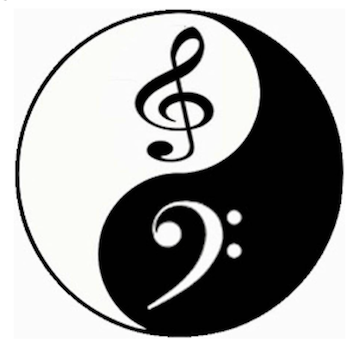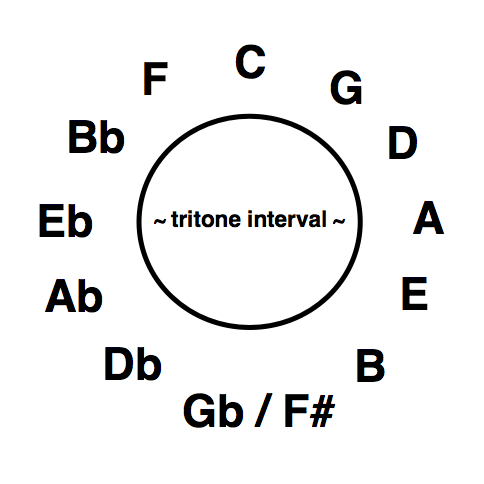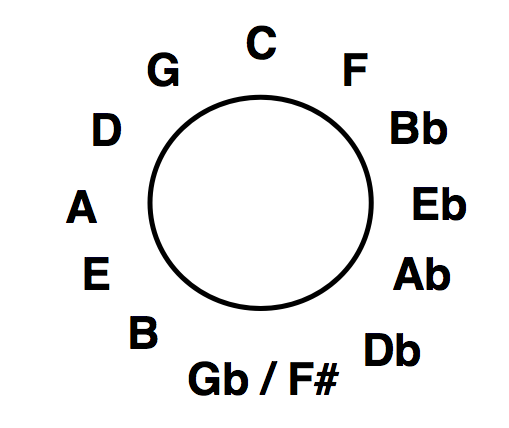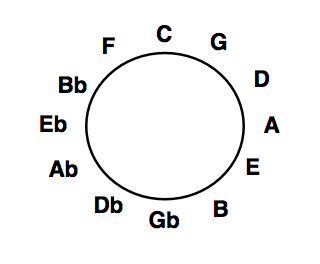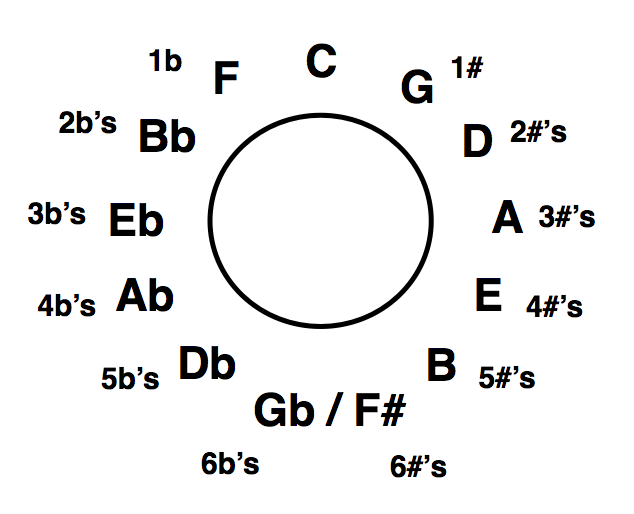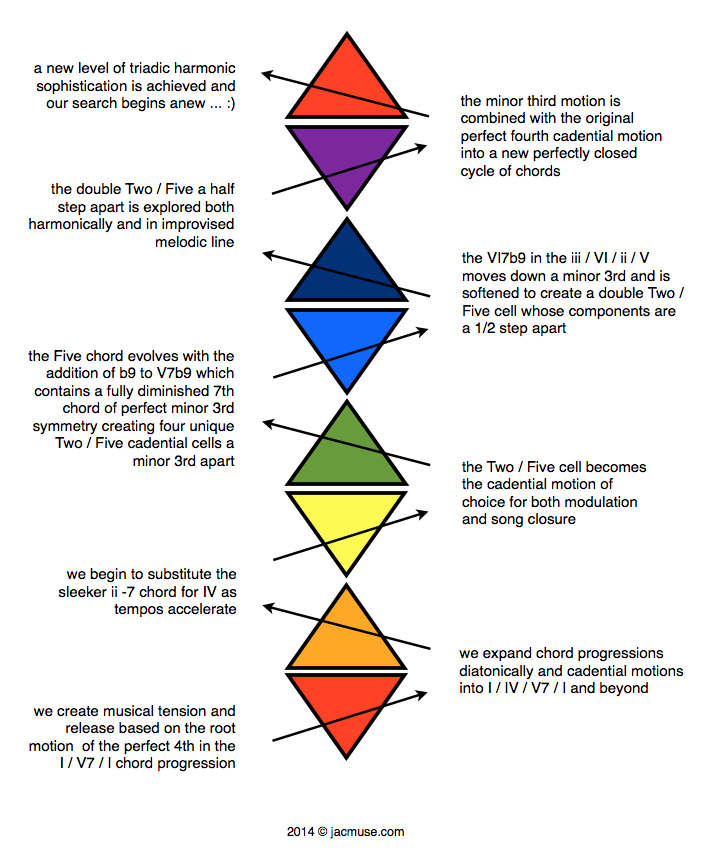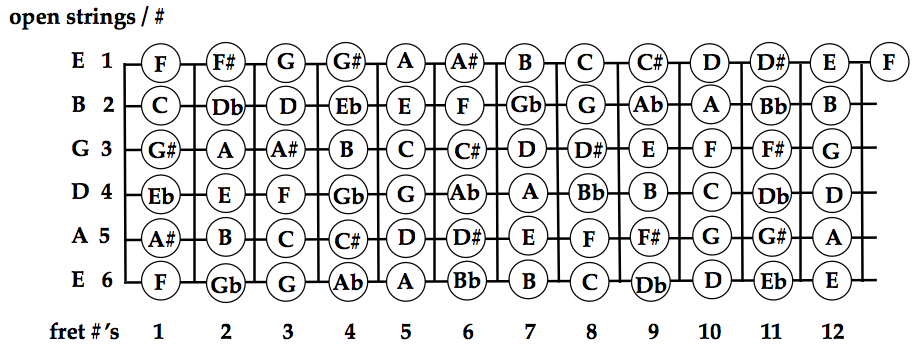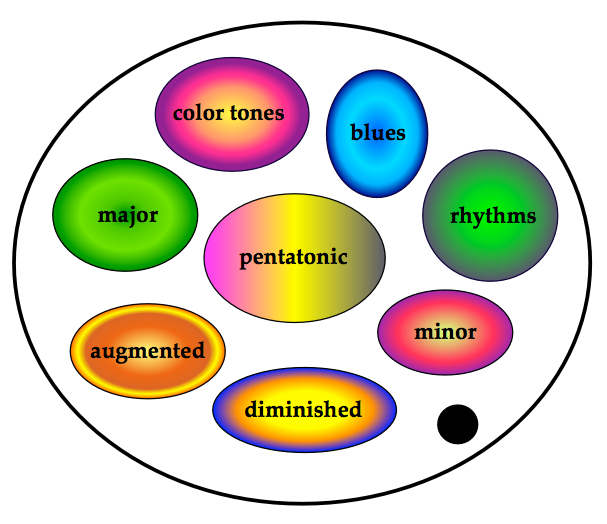| key center |
a key center is comprised of a set group of pitches that features one pitch as its tonal center, One, the remaining pitches orbit around and create the various tonal gravities that we build the tension / release dynamic in our songs. |
| 12 major keys |
how many major keys there are. |
| 12 minor keys |
how many minor keys we get. |
| cycle of 5th's |
a "pitch
clock" that includes our 12 pitches, arranged clockwise by the interval of a perfect
fifth, that pictorially resembles our 12 hour "face" clock. |
| A T F A W |
that from each of our 12 unique pitches, all are equal, that we can create and intervals, scale, mode, arpeggio chord, song and local universe, from each of the 12 pitches equally, all are equal, we pick one to be the center of a song, but all can be chosen, we can create anything ( any musical event ) from anywhere ( any of the 12 pitches ). |
| one pitch center |
we 'solar system' our music, chose one to be the Sun, and all else gravitates towards the One. |
| diatonic 3 and 3 |
that in each key center, it'd seven pitches can create the One, Four and Five chords in major and minor. |
| tonal gravity |
with one pitch chosen as a center, all others are drawn in by tonal gravity moving through time. |
| sharp keys |
key centers that use sharps to build up the relative major / minor group of pitches. |
| flat keys |
key centers that use flats to build up the relative major / minor group of pitches. |
| transposing |
recreate an interval sequence in a new key, transpose the pitches of one key to another. |
| scale / arpeggio / chord |
the core evolution that creates three main compositional elements. |
| key centers |
Please get pencil and paper to start from scratch, and build up a 'chord coffee spelling chart' styled presentation for each of our pitches, into their relative, diatonic, relatives by diatonic, twelve relative major / minor key centers. |
| __________ |
a key center is comprised of a set group of pitches that features one pitch as its tonal center, One, the remaining pitches orbit around and create the various tonal gravities that we build the tension / release dynamic in our songs. |
| 12 major keys |
how many ________ there are. |
| ____ minor keys |
how many minor keys we get. |
| cycle of 5th's |
a "pitch
clock" that includes all ______ pitches, arranged clockwise by the interval of a perfect
fifth, that pictorially resembles our 12 hour "face" clock. |
| ______?______ |
that from each of our 12 unique pitches, all are equal, that we can create and intervals, scale, mode, arpeggio chord, song and local universe, from each of the 12 pitches equally, all are equal, we pick one to be the center of a song, but all can be chosen, we can create anything ( any musical event ) from anywhere ( any of the 12 pitches ). |
| one pitch center |
we 'solar system' our music, chose one to be the Sun, and all else ________ towards the One. |
| diatonic 3 and 3 |
that in each key center, its seven pitches can create the One, Four and ______ triads in major and minor. |
| tonal ______ |
with one pitch chosen as a center, all others are drawn in by tonal gravity moving through time. |
| _______ keys |
key centers that use sharps to build up the relative major / minor group of pitches. |
| flat keys |
key centers that use ______ to build up the relative major / minor group of pitches. |
| ____?_____ |
recreate an interval sequence in a new key, transpose the pitches of one key to another. |
| scale / arpeggio / chord |
the core _________ that creates three main compositional elements. |
| key centers |
Please get pencil and paper to start from scratch, and build up a 'chord coffee spelling chart' styled presentation for each of our pitches, into their relative, diatonic, relatives by diatonic, twelve relative major / minor key centers. |
| archeology |
the study of
human cultures from artifacts |
| computer
modeling |
using our modern
technology of computers to recreate, speculate, envision and expand the 'what
if' possibilities of information and material fragments we do have. |
| cycle
of fifths |
a "pitch
clock" that includes our 12 pitches, arranged clockwise by the interval of a perfect
fifth, that pictorially resembles our 12 hour "face" clock |
| fundamental
pitch |
the pitch created
by the entire length of a taut string, column of air etc., also the root pitch of a key
center within the 12 tone system |
| overtones |
tones that
naturally exist over the fundamental pitch |
| music
notation |
symbols used to
preserve in writing our musical sounds |
| monophonic |
music with one
melodic line |
| polyphonic |
music with two or
more melodic lines |
| homophonic |
music with one
melody line supported by chords |
| New
World |
a phrase used by
folks the world over, say starting 500 years ago, to describe the existence of a
continental land mass that would be called the "Americas", north and south, that
became the vision of a new home for people from every part of our world where they could
live in a world of opportunity. |
